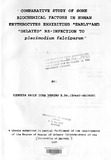| dc.contributor.author | Werimo, Erick O | |
| dc.date.accessioned | 2013-05-16T11:30:30Z | |
| dc.date.available | 2013-05-16T11:30:30Z | |
| dc.date.issued | 1997 | |
| dc.identifier.citation | M.Sc (Biochemistry) | en |
| dc.identifier.uri | http://erepository.uonbi.ac.ke:8080/xmlui/handle/123456789/23594 | |
| dc.description | Master of Science Thesis | en |
| dc.description.abstract | Malaria remains themost important ofall tropical diseases.
Some 200 million individuals in 102 countries are at risk. Nearly
85% of the cases and 90% of the carriers are found in tropical
Africa. InKenya, out of a total population 30million 22million
people are at risk of infection.
Previous studies at Saradidi, Western Kenya have indicated
that malaria (P. falciparum), infection varies from individual
to individual. In one such study a group of inhabitants within
similar geographical environment and having similar incidence of
malaria, were initially treated for malaria and later monitored
for re-infection for aperiod of 96days. Results from that study
indicated that some individuals were re-infected by the malaria
parasites much earlier than others. For comparative study of
these inhabitants, those that were re-infected before 96 days
were classified as "early re-infected group" whereas those that
were re-infected after 96 days were classified as "delayed
re-il-ifectedgroup" | en |
| dc.description.sponsorship | University of Nairobi | en |
| dc.language.iso | en | en |
| dc.title | Comparative study of some biochemical factors in human erythrocytes exhibiting "early"and "delayed" re-infection to placimodium falciparum" | en |
| dc.type | Thesis | en |
| local.publisher | Department of Chemistry, University of Nairobi | en |

